story and photos by Jamie Rector
Detroit has well earned its moniker of Motor City. Its history for most of the last century has been defined by the automotive industry. If you like cars, there is plenty here to entertain and educate you. Even if you aren’t an automobile aficionado, the displays offered give a well-rounded history of the horseless carriage and how it has affected the world.
Dearborn, a suburb of Detroit on the Rouge River, is the home of the Ford Company. A good place to start your visit is with a stay at the Dearborn Inn across the street from the Henry Ford Museum. The Dearborn Inn was built by Ford, but is now part of the Marriott chain. It not only offers a more traditional hotel experience, but in the back of the Inn are several separate houses that are exact replicas of the homes of Edgar Alan Poe, Walt Whitman, Oliver Wolcott, Patrick Henry and Barbara Fritchie.
The Henry Ford has a whole amusement park of options to visit. It incorporates the Henry Ford Museum, Greenfield Village living history museum, The Ford Rouge Factory Tour, the Henry Ford IMAX Theater and the Benson Research Center.
The Henry Ford Museum
The main Henry Ford Museum is a great way to spend a rainy day. 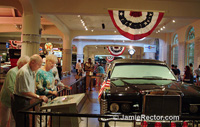 You could be there all day and not see everything. You might expect a museum named for Henry Ford to be all about cars, and there are plenty of exhibits on the development of the automobile. But the majority of space if given over to what began as Henry Ford’s collection of the evidence of American ingenuity in technology and ideas. Ford’s vision included collecting and preserving the objects in people’s daily lives as a way of documenting American history. Throughout the museum and the adjacent Greenfield Village, are mementos from the people Ford cared about as well as things that attracted him. He has Thomas Edison’s last breath contained in a small vial as well as some authentic and replica pieces of his best friend’s life.
You could be there all day and not see everything. You might expect a museum named for Henry Ford to be all about cars, and there are plenty of exhibits on the development of the automobile. But the majority of space if given over to what began as Henry Ford’s collection of the evidence of American ingenuity in technology and ideas. Ford’s vision included collecting and preserving the objects in people’s daily lives as a way of documenting American history. Throughout the museum and the adjacent Greenfield Village, are mementos from the people Ford cared about as well as things that attracted him. He has Thomas Edison’s last breath contained in a small vial as well as some authentic and replica pieces of his best friend’s life.
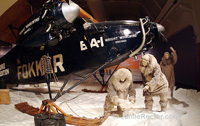 In the Automobile in American Life exhibit, there are antique vehicles, test cars that never made it into the market, race cars and automobiles developed through the 20th century. There are also icons of American life that developed because of the more mobile lifestyle brought on by ease of transportation such as roadside diners and fast food restaurants. Other exhibits showcase the history of other modes of transportation from the stage coach to the locomotive to the airplane.
In the Automobile in American Life exhibit, there are antique vehicles, test cars that never made it into the market, race cars and automobiles developed through the 20th century. There are also icons of American life that developed because of the more mobile lifestyle brought on by ease of transportation such as roadside diners and fast food restaurants. Other exhibits showcase the history of other modes of transportation from the stage coach to the locomotive to the airplane.
In the Presidential Limousines exhibit, you can see the limo that Kennedy was riding in when he was assassinated. There’s also one that was owned by four presidents; Nixon, Ford, Carter and Reagan. The oddities collection includes the tiny vehicle that belonged to Tom Thumb.
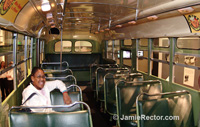 In 2006, the Henry Ford introduced a new exhibit called With Liberty and Justice for All. It includes artifacts from the American Revolution through the civil rights movement. You can only look at Abraham Lincoln’s chair form the Ford Theatre where he was shot and George Washington’s camp bed, but you can climb on the restored Montgomery City Lines bus and sit in the seat where Rosa Parks sat and changed the world.
In 2006, the Henry Ford introduced a new exhibit called With Liberty and Justice for All. It includes artifacts from the American Revolution through the civil rights movement. You can only look at Abraham Lincoln’s chair form the Ford Theatre where he was shot and George Washington’s camp bed, but you can climb on the restored Montgomery City Lines bus and sit in the seat where Rosa Parks sat and changed the world.
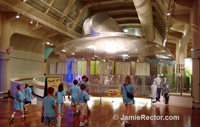 The Henry Ford has also restored the only remaining example of Buckminster Fuller’s Dymaxion House, a round, aluminum dwelling that was designed in 1946 to be inexpensive, easy to assemble and sturdy enough to withstand tornados. Your Place in Time has common everyday items identified by the generation that grew up with them, from the Progressives and War Generation through the Baby Boomers to the Gen Xers and the Next Generation. Other exhibit subjects include agricultural technology, silver and pewter, clocks, home arts and furnishings.
The Henry Ford has also restored the only remaining example of Buckminster Fuller’s Dymaxion House, a round, aluminum dwelling that was designed in 1946 to be inexpensive, easy to assemble and sturdy enough to withstand tornados. Your Place in Time has common everyday items identified by the generation that grew up with them, from the Progressives and War Generation through the Baby Boomers to the Gen Xers and the Next Generation. Other exhibit subjects include agricultural technology, silver and pewter, clocks, home arts and furnishings.
Greenfield Village
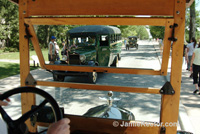 Outside the main museum, Greenfield Village covers 90 acres of the Ford Estate. It is the oldest and largest living history museum in the country. Much of it is outdoors, so an umbrella might come in handy, but there are tours in vintage Ford vehicles that will drive you through the village pointing out various buildings, including the 1929 Martha May Chapel, an English Cottage, a windmill and a clock shop built as a school. Of the 63 structures, 42 were brought here and 21 are replicas. Many of them have interior exhibits with staffed by costumed reenactors.
Outside the main museum, Greenfield Village covers 90 acres of the Ford Estate. It is the oldest and largest living history museum in the country. Much of it is outdoors, so an umbrella might come in handy, but there are tours in vintage Ford vehicles that will drive you through the village pointing out various buildings, including the 1929 Martha May Chapel, an English Cottage, a windmill and a clock shop built as a school. Of the 63 structures, 42 were brought here and 21 are replicas. Many of them have interior exhibits with staffed by costumed reenactors.
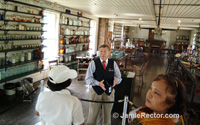 Structures related directly to Henry Ford include his actual boyhood home and replicas of his Bagley Avenue Workshop where he built his first “quadricycle” and a one quarter size replica of his first factory. Ford’s tribute to his friend Thomas Edison include Edison’s Fort Meyers Florida laboratory and replicas of his laboratory, glass shed, machine shop, office and library in Menlo Park New Jersey. The Village includes a Main Street with traditional trades and crafts and historic eating establishments and side streets with the homes, porches and parlors of historic individuals. There are also a number of working farms, mills and a railroad junction with train rides.
Structures related directly to Henry Ford include his actual boyhood home and replicas of his Bagley Avenue Workshop where he built his first “quadricycle” and a one quarter size replica of his first factory. Ford’s tribute to his friend Thomas Edison include Edison’s Fort Meyers Florida laboratory and replicas of his laboratory, glass shed, machine shop, office and library in Menlo Park New Jersey. The Village includes a Main Street with traditional trades and crafts and historic eating establishments and side streets with the homes, porches and parlors of historic individuals. There are also a number of working farms, mills and a railroad junction with train rides.
The Ford Rouge Factory Tour
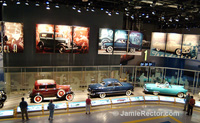 Another part of the Ford extravaganza is The Rouge Tour. A tour bus picks you up and drops you off right in front of the Ford Museum. It is an off site tour of the cars being made in Ford’s Rouge Factory, named for the Rouge River running beside it. There is a multi media introduction that gives a multi-sensory idea of some of the history with seven gigantic screens and chairs that swivel 360 degrees and shake below you. Hot air blows on you; strobes flash. It’s a dramatic display – almost too much.
Another part of the Ford extravaganza is The Rouge Tour. A tour bus picks you up and drops you off right in front of the Ford Museum. It is an off site tour of the cars being made in Ford’s Rouge Factory, named for the Rouge River running beside it. There is a multi media introduction that gives a multi-sensory idea of some of the history with seven gigantic screens and chairs that swivel 360 degrees and shake below you. Hot air blows on you; strobes flash. It’s a dramatic display – almost too much.
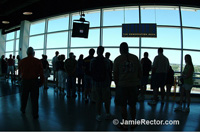 The tour then moves to the observation deck where they show you the world’s largest eco-roof on the top of the Ford building. It is a living, breathing lawn that is used to naturally help keep the building 10 degrees cooler in summer and also warmer in winter. When that part of the tour is over, there’s a self-guided tour around the actual factory. High above the employees, you can walk a circle around the entire top of the plant and watch the cars being pieced together, from frame to windshield wipers.
The tour then moves to the observation deck where they show you the world’s largest eco-roof on the top of the Ford building. It is a living, breathing lawn that is used to naturally help keep the building 10 degrees cooler in summer and also warmer in winter. When that part of the tour is over, there’s a self-guided tour around the actual factory. High above the employees, you can walk a circle around the entire top of the plant and watch the cars being pieced together, from frame to windshield wipers.
Automobile Hall of Fame
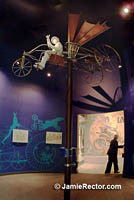 If you haven’t had enough of the auto culture, on the same property as the Ford Museum is the independent Automotive Hall of Fame. This is less a look at how cars are made and more about the people in the world that have had a major impact on the automotive industry in every corner of the world. Every year they add new inductees and celebrate people such as Sakichi Toyoda, founder of Toyota Industries and Soichiro Honda, founder of Hondo Motor Company as well as the dealerships that sold the most vehicles. There are interactive displays where kids or adults can build their own cyber hotrods. It’s not very big, so it won’t take too much time, but it’s a nice supplement to the rest of what Motor City has to offer.
If you haven’t had enough of the auto culture, on the same property as the Ford Museum is the independent Automotive Hall of Fame. This is less a look at how cars are made and more about the people in the world that have had a major impact on the automotive industry in every corner of the world. Every year they add new inductees and celebrate people such as Sakichi Toyoda, founder of Toyota Industries and Soichiro Honda, founder of Hondo Motor Company as well as the dealerships that sold the most vehicles. There are interactive displays where kids or adults can build their own cyber hotrods. It’s not very big, so it won’t take too much time, but it’s a nice supplement to the rest of what Motor City has to offer.
The Henry Ford
20900 Oakwood Blvd.
Dearborn , MI 48124-4088
(313) 982-6100, 9:00am-5:00pm, EST
www.hfmgv.org
Automotive Hall of Fame
21400 Oakwood Boulevard
Dearborn, Michigan USA
(313) 240-4000
www.automotivehalloffame.org

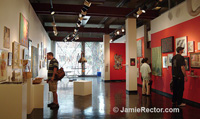 Detroit isn’t known as an arts Mecca, but it has plenty of art around to appreciate, from the classics to the avant-garde. From the centuries of fine art on display at the Detroit Institute of Arts to the diversity of vendors at the Artist Market – established in 1932 and still going strong – to newer clusters of galleries springing up in nearby Wyandotte, Detroit has a long history of art appreciation and production.
Detroit isn’t known as an arts Mecca, but it has plenty of art around to appreciate, from the classics to the avant-garde. From the centuries of fine art on display at the Detroit Institute of Arts to the diversity of vendors at the Artist Market – established in 1932 and still going strong – to newer clusters of galleries springing up in nearby Wyandotte, Detroit has a long history of art appreciation and production.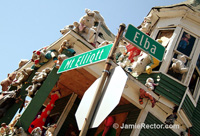 covers one block in a low-income residential neighborhood. Some people love it and some hate it, but either way, it’s worth a look to see what everyone is talking about. The controversy has contributed to making it the third most visited site in Detroit.
covers one block in a low-income residential neighborhood. Some people love it and some hate it, but either way, it’s worth a look to see what everyone is talking about. The controversy has contributed to making it the third most visited site in Detroit.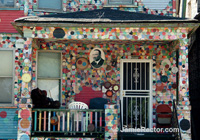 Polka Dots are splashed all over the run down neighborhood. The dots symbolize the various races of the world coming together. Houses are decorated in themes. The various exhibits represent the human condition with seemingly random pieces of junk; Stuffed animals, furniture, shoes, vacuum cleaners
you name it, it’s in there somewhere. If it’s not there, I’m sure it could easily be incorporated. Make sure you look for the series of faces around the neighborhood representing the diversity of the faces of God. The faces are painted on car hoods and have been exhibited in other locations as The Painted Hoods of Tyree Guyton.
Polka Dots are splashed all over the run down neighborhood. The dots symbolize the various races of the world coming together. Houses are decorated in themes. The various exhibits represent the human condition with seemingly random pieces of junk; Stuffed animals, furniture, shoes, vacuum cleaners
you name it, it’s in there somewhere. If it’s not there, I’m sure it could easily be incorporated. Make sure you look for the series of faces around the neighborhood representing the diversity of the faces of God. The faces are painted on car hoods and have been exhibited in other locations as The Painted Hoods of Tyree Guyton.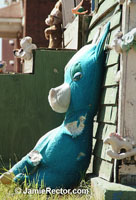 The Heidelberg Project provides after-school art education to neighborhood children and has driven most of the illegal activity out of the neighborhood by making it impossible for them to do business under the scrutiny of hundreds of visitors a day. The City has demolished several of Guyton’s creations over the years, which was easy for them to do since the houses were abandoned and derelict City-owned properties before Guyton started working on them. Simultaneously, City art institutions and the international arts community have bestowed upon Guyton a variety of prestigious arts awards and the artist has appeared on Good Morning America and Oprah to talk about the project.
The Heidelberg Project provides after-school art education to neighborhood children and has driven most of the illegal activity out of the neighborhood by making it impossible for them to do business under the scrutiny of hundreds of visitors a day. The City has demolished several of Guyton’s creations over the years, which was easy for them to do since the houses were abandoned and derelict City-owned properties before Guyton started working on them. Simultaneously, City art institutions and the international arts community have bestowed upon Guyton a variety of prestigious arts awards and the artist has appeared on Good Morning America and Oprah to talk about the project.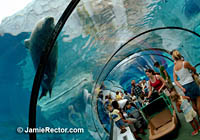 Your first stop should be the Ford Education Center. For an extra charge, you can try out the Wild Adventure Simulator, a virtual reality ride offering movement and sound to create an adventure for your senses. There are a variety of different animated simulations that alternate, so depending on when you visit, you may find yourself saving dinosaurs from extinction, searching for life on the bottom of the ocean or seeing the world through the eyes of birds, bees, tigers and other creatures.
Your first stop should be the Ford Education Center. For an extra charge, you can try out the Wild Adventure Simulator, a virtual reality ride offering movement and sound to create an adventure for your senses. There are a variety of different animated simulations that alternate, so depending on when you visit, you may find yourself saving dinosaurs from extinction, searching for life on the bottom of the ocean or seeing the world through the eyes of birds, bees, tigers and other creatures.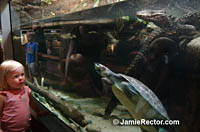 The award-winning Amphibiville is populated with hundreds of amphibians like frogs and salamanders, some living on two acres of outdoor wetlands, and others in recreated environments inside the National Amphibian Conservation Center. The intricately constructed exhibits in the Center are inhabited by creatures from around the world. Some of the indoor habitats are created with glass walls to the outside so you can see what’s going on in the outdoor habitat, even if you’re staying inside out of the rain. Even if it’s not raining outside, it might be raining in the Immersion Gallery where you can walk through a recreated environment that may be experiencing rain or fog.
The award-winning Amphibiville is populated with hundreds of amphibians like frogs and salamanders, some living on two acres of outdoor wetlands, and others in recreated environments inside the National Amphibian Conservation Center. The intricately constructed exhibits in the Center are inhabited by creatures from around the world. Some of the indoor habitats are created with glass walls to the outside so you can see what’s going on in the outdoor habitat, even if you’re staying inside out of the rain. Even if it’s not raining outside, it might be raining in the Immersion Gallery where you can walk through a recreated environment that may be experiencing rain or fog.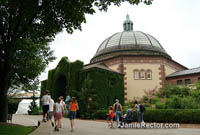 The Wildlife Interpretive Gallery is housed in the zoo’s oldest building which is 10,000 square feet of interactive displays, wildlife theatre, video and multi-media to draw in visitors for a fun way to learn about the animals and nature. There is also an exhibit hall within that offers rotating exhibits.
The Wildlife Interpretive Gallery is housed in the zoo’s oldest building which is 10,000 square feet of interactive displays, wildlife theatre, video and multi-media to draw in visitors for a fun way to learn about the animals and nature. There is also an exhibit hall within that offers rotating exhibits.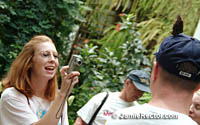 The Butterfly Garden offers first hand experience with a wide range of beautiful butterflies from Costa Rica and El Salvador. The Holden Reptile Museum houses the zoo’s reptile collection. The Penguinarium also offers a covered climate-controlled display of a variety of breeds of the ice bound birds.
The Butterfly Garden offers first hand experience with a wide range of beautiful butterflies from Costa Rica and El Salvador. The Holden Reptile Museum houses the zoo’s reptile collection. The Penguinarium also offers a covered climate-controlled display of a variety of breeds of the ice bound birds.